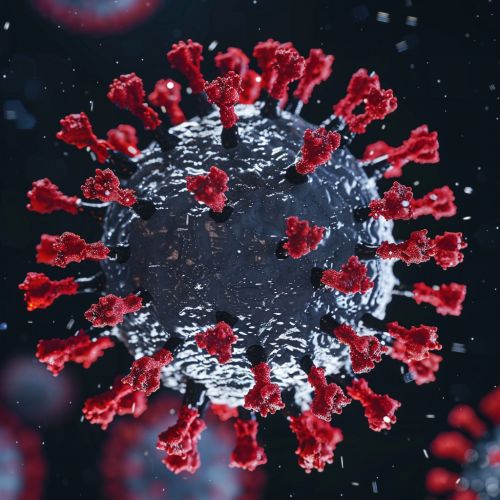Lentiviruses
Introduction
Lentiviruses are a genus of viruses within the family Retroviridae, characterized by their long incubation periods and ability to cause chronic and progressive diseases. The name "lentivirus" is derived from the Latin word "lentus," meaning "slow," reflecting the slow onset of disease. These viruses are enveloped, single-stranded RNA viruses that integrate into the host genome, making them persistent and difficult to eradicate. Lentiviruses are notable for their ability to infect non-dividing cells, which distinguishes them from other retroviruses.
Classification and Structure
Lentiviruses belong to the family Retroviridae, which also includes other genera such as Alpharetrovirus, Betaretrovirus, and Gammaretrovirus. The genus Lentivirus is further divided into several species, including Human Immunodeficiency Virus (HIV), Simian Immunodeficiency Virus (SIV), Feline Immunodeficiency Virus (FIV), and Equine Infectious Anemia Virus (EIAV).
The structure of lentiviruses is complex, consisting of an envelope, a matrix, a capsid, and a core containing the RNA genome. The envelope is derived from the host cell membrane and contains viral glycoproteins, which are crucial for virus entry into host cells. The matrix protein lies beneath the envelope and provides structural support. The capsid encases the viral RNA and associated proteins, including reverse transcriptase, integrase, and protease, which are essential for viral replication.
Genome and Replication Cycle
The lentiviral genome is approximately 9-10 kilobases in length and consists of several genes, including gag, pol, and env, which encode structural proteins, enzymes, and envelope proteins, respectively. Additionally, lentiviruses have accessory genes such as vif, vpr, vpu, tat, and rev, which play roles in viral replication and pathogenesis.
The replication cycle of lentiviruses involves several key steps: 1. **Attachment and Entry**: The virus attaches to the host cell via interactions between its envelope glycoproteins and host cell receptors, such as CD4 and chemokine receptors in the case of HIV. 2. **Reverse Transcription**: The viral RNA genome is reverse transcribed into complementary DNA (cDNA) by the enzyme reverse transcriptase. 3. **Integration**: The cDNA is transported into the nucleus and integrated into the host genome by the enzyme integrase. 4. **Transcription and Translation**: The integrated viral DNA (provirus) is transcribed into viral RNA by the host cell's machinery. This RNA serves as both the genome for new virions and as mRNA for the production of viral proteins. 5. **Assembly and Budding**: Newly synthesized viral proteins and RNA assemble at the host cell membrane, forming new virions that bud off from the cell, acquiring their envelope in the process.
Pathogenesis and Clinical Manifestations
Lentiviruses cause a range of diseases in different host species. The most well-known lentivirus, HIV, is the causative agent of AIDS. HIV primarily infects CD4+ T cells, leading to their depletion and resulting in immunodeficiency. This makes individuals susceptible to opportunistic infections and certain cancers.
Feline Immunodeficiency Virus (FIV) causes a similar immunodeficiency syndrome in cats, characterized by chronic infections, weight loss, and lymphadenopathy. Equine Infectious Anemia Virus (EIAV) infects horses and causes recurrent episodes of fever, anemia, and edema.
The pathogenesis of lentiviral infections involves both direct viral cytopathic effects and immune-mediated damage. Chronic immune activation and inflammation contribute to disease progression and the development of complications.
Host-Virus Interactions and Immune Evasion
Lentiviruses have evolved various strategies to evade the host immune response. These include high mutation rates, which lead to rapid antigenic variation, and the ability to infect immune cells, thereby disrupting immune function. Additionally, lentiviruses can downregulate the expression of host cell surface molecules, such as MHC class I, to avoid detection by cytotoxic T lymphocytes.
The accessory proteins of lentiviruses also play crucial roles in immune evasion. For example, the HIV protein Nef downregulates CD4 and MHC class I molecules, while Vif counteracts the host restriction factor APOBEC3G.
Diagnosis and Treatment
Diagnosis of lentiviral infections typically involves serological tests to detect antibodies against viral proteins, as well as molecular techniques such as PCR to detect viral RNA or DNA. For HIV, common diagnostic tests include ELISA, Western blot, and nucleic acid amplification tests.
Treatment of lentiviral infections, particularly HIV, has been revolutionized by the development of antiretroviral therapy (ART). ART involves the use of multiple drugs that target different stages of the viral life cycle, including reverse transcriptase inhibitors, protease inhibitors, integrase inhibitors, and entry inhibitors. While ART can effectively suppress viral replication and improve immune function, it is not curative, and lifelong treatment is required.
Research and Future Directions
Ongoing research on lentiviruses aims to better understand their biology, pathogenesis, and interactions with the host immune system. This knowledge is critical for the development of new therapeutic strategies and vaccines. One area of active research is the use of gene editing technologies, such as CRISPR/Cas9, to target and eliminate integrated proviral DNA.
Another promising avenue is the development of broadly neutralizing antibodies (bNAbs) that can target conserved regions of the viral envelope glycoproteins. These antibodies have shown potential in both therapeutic and preventive settings.
See Also
- Retrovirus
- HIV
- AIDS
- Feline Immunodeficiency Virus
- Equine Infectious Anemia Virus
- Antiretroviral therapy


